If you ask foreign visitors to Iran about the most characteristic future they discovered during excursions in the ancient land, the most possible answers may be somewhat like these: “It is the friendliest country on Earth with loads of warm-hearted welcome!”; “It is the jewel in Islam’s crown in terms of architecture”; “Being home to fascinating cultural heritage sites”; or “a land where echoes of ancient civilizations still resonate down through the ages!”
Iran is heaven for those interested in cultural tourism, a subset of traveling that traces the nation’s lifestyle in various geographical areas, their history, their arts, architecture, religion(s), and other elements helped shape their way of life over time. Modern Iran was once the heart of the great Persian Empire that stretched from Greece boundaries all the way to China.
It is filled with numerous tourist spots such as bazaars, museums, mosques, bridges, bathhouses, madrasas, mausoleums, churches, towers, and mansions, of which 24 being inscribed on the UNESCO World Heritage list. These sites provide an ample opportunity to learn more about the country with their own eyes and touch its marvelous and incredibly rich cultural heritage with its own hands. Even if you don’t plan to visit in the near future, you can still marvel at these 20 amazing ones selected as the must-see cultural sites in Iran:
1. Imam Mosque, Isfahan

At the southern end of Isfahan’s main square stands the big, grand and impressive Imam Mosque (formerly known as the Shah Mosque), which is not only impressive because of its sheer size and incredible decorations, but also helps to get a good impression of the needs and challenges of always on-going restoration works.
A very picturesque huge entrance portal welcomes people to the mosque. It is built to face the square though the mosque is oriented towards Mecca. A short corridor connects the square to the inner courtyard that is surrounded by four imposing iwans (porticos) with a pool dedicated to ritual ablutions nesting in the middle.
Visitors to the mosque are mainly overwhelmed with good views of the main dome with its glorious profusion of turquoise-shaded tiles. The craftsmanship continues and is intricate with amazing views both on the façade and the interior. The monuments boast perfect proportions and iconic blue-tiled mosaics.
2. Persepolis, Shiraz

Persepolis, also known as Takht-e Jamshid, ranks among the archaeological sites with no equivalent, considering its unique architecture, urban planning, construction technology, and arts. The site, which as the ceremonial capital of the Achaemenid Persian Empire (c. 550 – 330BC) was burnt by Alexander the Great in 330 BC apparently as a revenge to the Persians because the Persian King Xerxes had probably burnt the Greek City of Athens around 150 years earlier.
The magnificent ruins of Persepolis lie at the foot of Kuh-e Rahmat (Mountain of Mercy), which was the ceremonial capital of the Achaemenid Empire. Situated 60 kilometers northeast of the city of Shiraz in Fars province.
3. Imam Reza Shrine, Mashhad
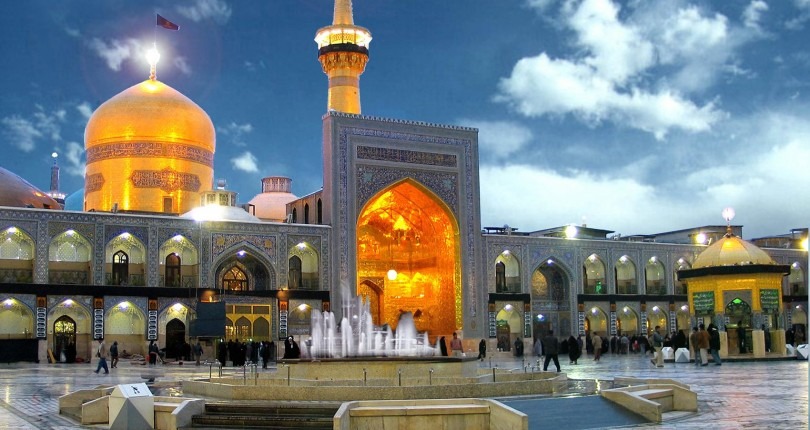
Mashhad, the capital of Khorasan Razavi province, typically attracts thousands of domestic pilgrims each day. The raison d’être is the holy shrine of Imam Reza (AS), the eighth Shia Imam. Visiting the holy shrine and its complex is a pure and celestial journey for the Muslims.
The complex includes the 15th-century Goharshad mosque, a museum, a library, four seminaries, a cemetery, the Razavi University of Islamic Sciences, a dining hall for pilgrims, vast prayer halls, amongst other buildings. The complex is one of the tourism centers in the country and has been described as “the heart of the Shia Iran”.
Amid tearful prayer and meditation, the climax to any Shrine pilgrimage is touching and kissing the Zarih (gold-latticed enclosure), which covers the tomb of Imam Reza (AS) beneath the iconic golden dome. Non-Muslims are generally excluded from visiting this inner sanctuary but can see a since-replaced older Zarih on display in the museum.
4. Golestan Palace, Tehran
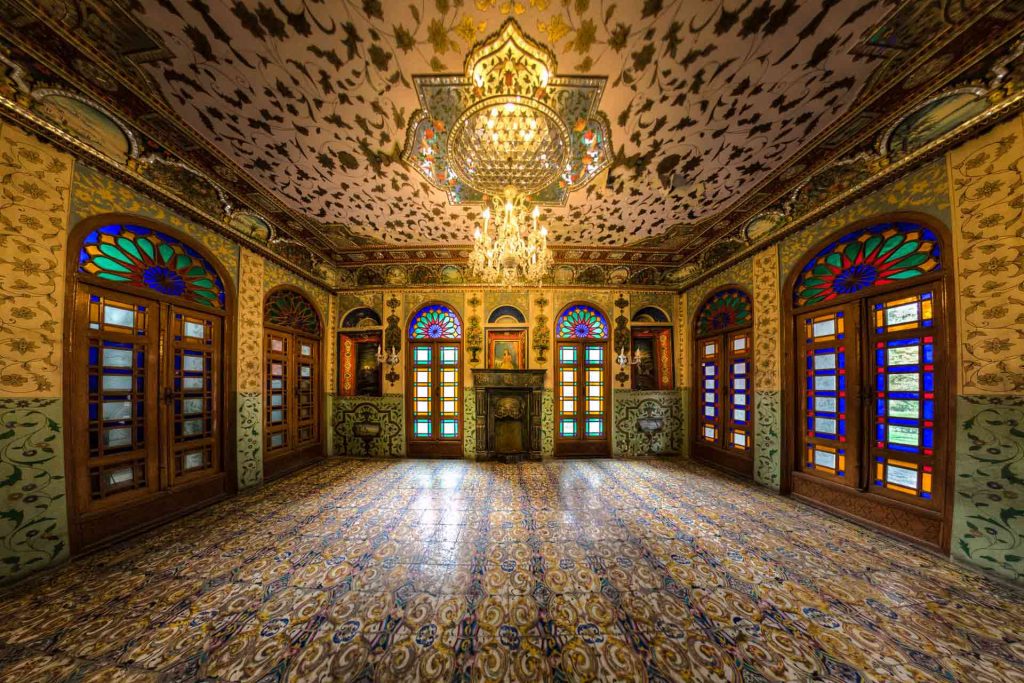
Located in the heart and historic core of Tehran, the Golestan Palace complex is one of the oldest in the Iranian capital, originally built during the Safavid dynasty (1501–1736) in the then walled town.
Following extensions and additions, it received its most characteristic features in the 19th century, when the palace complex was selected as the royal residence and seat of power by the Qajar ruling family (1789-1925).
At present, the Golestan Palace complex consists of eight key palace structures mostly used as museums and the eponymous gardens, a green shared center of the complex, surrounded by an outer wall with gates. The complex exemplifies architectural and artistic achievements of the Qajar era including the introduction of European motifs and styles into Persian arts.
5. Nasir Al-Mulk Mosque, Shiraz
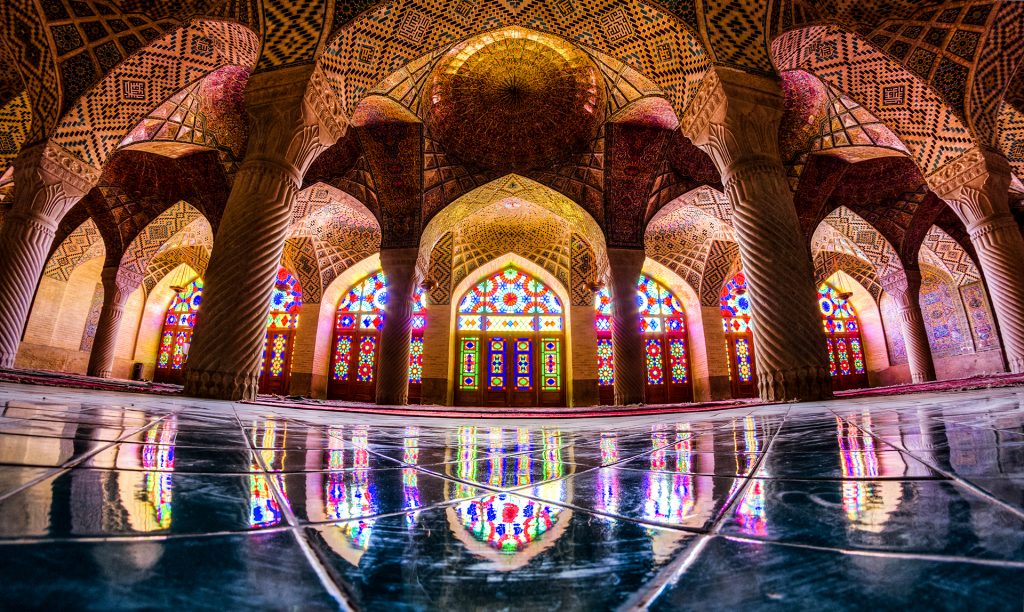
The atmospheric Nasir al-Mulk Mosque sometimes referred to as the “Pink Mosque”, situated in downtown Shiraz, southern Iran, has long been a prime destination for international and domestic travelers.
The name “Pink Mosque” is driven from abundant pink-colored tilework that dominates its courtyard and exteriors facade. Nasir al-Molk has arrays of delicate mirror work and stuccowork, which are interwoven with arabesque designs and tilework.
Reflection of light through the stained-glass sheets, abundant carved pillars, and lavishly-created polychrome faience are amongst elements that enhance the beauty of the mosque’s prayer hall. In case one is willing to get shots it is widely recommended to come as early as possible in the morning to picture the prayer hall when it is lit up through the colorful glass frames.
6. Eram Garden and Palace, Shiraz

Eram Garden, widely famous for its towering cypress trees, is one the impressive and most-visited gardens in the country. Visitors to the garden may be amazed by its peaceful atmosphere that feathers fragrance of flowers, bird songs, and dance of blossoms all intertwined with rich Persian art and architecture.
Located in southern city of Shiraz, it was converted into a botanical garden by Shiraz University in the early 1980s.
Narratives say the garden goes down to the time of the Seljuk Dynasty (ca. 1040–1196), but what visitors see today date from the 18th century onwards. UNESCO describes the Persian Garden an idea that combines natural elements with manmade components in order to materialize the concept of Eden or Paradise on Earth.
7. Shah Cheragh, Shiraz
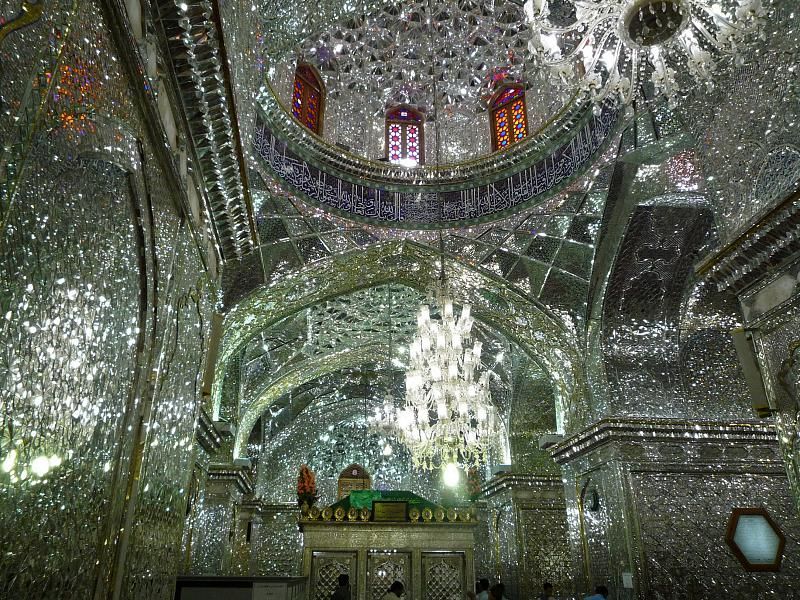
The centuries-old Shah Cheragh (literally meaning the “King of Light”) is a major mausoleum and pilgrimage site, where Sayyed Mir Ahmad, one of the brothers of Imam Reza (AS), is laid to rest, in the touristic city of Shiraz.
Insides are lined with dazzling glass tiles that bounce the light in every direction, and intricate geometric designs that create a stunning otherworldly light show.
The mausoleum boasts architectural elements and motifs from various centuries and its courtyard and tilework represent relatively modern embellishments from the late-Qajar period. Its blue-tiled dome is flanked by dazzling gold-tipped minarets.
There is also a modest museum in the northwestern corner of the courtyard, next to the shrine, which showcases shrine-related objects, including some highly prized old Qurans and an exquisite door embellished with silver and gold.
Each day, the shrine draws hundreds of the faithful from all over the country or even abroad. Women must wear a chador (open cloaks that leave the face exposed) within the whole shrine complex, available for free at the women’s entrance.
8. Bam citadel, Kerman

The Bam citadel (locally called “Arg-e Bam”) and its cultural landscape, located on the southern edge of the Iranian high plateau, in Kerman province, is highly regarded as an outstanding example of an ancient fortified settlement built in vernacular technique using mud layers.
The massive fortress and its environs were almost completely brought down to earth due to a devastating earthquake on December 26, 2003. Most of what visitors now see at the site is restored and replicas of the original structure being restored from 2004 onwards.
The origins of the adobe citadel can be traced back to the Achaemenid period (6th to 4th centuries BC) and even beyond. The ensemble was on crossroads of important trade routes as well in its heyday sometime between 7th to 11th centuries.
9. Soltaniyeh dome, Zanjan
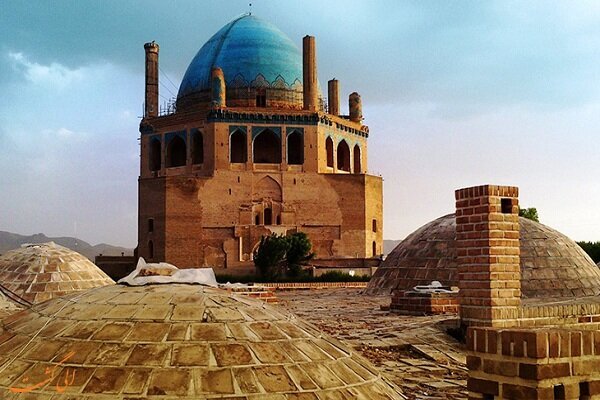
Dominating the skyline, the 14th-century Soltaniyeh dome (locally known as “Gonbad-e Soltaniyeh”) is highly recognized as an architectural masterpiece particularly due to its innovative double-shelled dome and elaborate interior decoration.
The mausoleum’s interior decoration is so outstanding that scholars like A.U. Pope has described the building as “anticipating the Taj Mahal”. The gigantic dome is embellished with turquoise-blue faience tiles, rising dramatically 48m above from its base that neighbors dusty archaeological digs and crumbling walls.
The dome is the earliest extant example of its type in the country and became an important reference for the later development of the Islamic dome. The city of Soltaniyeh was briefly the capital of Persia’s Ilkhanid dynasty (a branch of the Mongol dynasty) during the 14th century.
Also, the extremely rich interior of the mausoleum, which includes elaborate brickwork, glazed tiles, marquetry, or designs in inlaid materials, stucco, and frescoes, can be conceived as a masterpiece in the arena of Islamic architecture.
10. Valley of the Stars, Qeshm Island
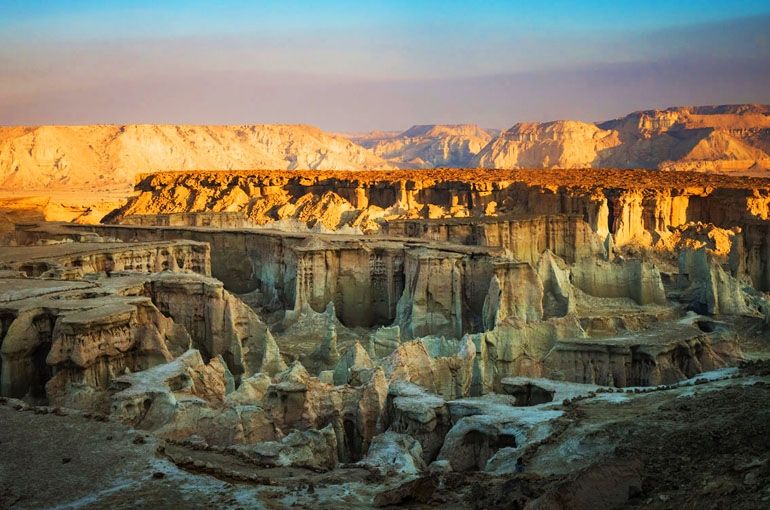
Stars Valley, also called, the Valley of Stars offers a pristine nature of rock formations, which easily recall, a little imagination, the shapes of animals, faces, among others.
Located on the west of the village of Berkeh Khalaf on the Qeshm Island in the Persian Gulf, the bizarre landscape has been created as the result of the erosion of soil and stones by wind and rain over hundreds of millennia.
Some locals believe that a star once fell on this area thereby creating the rocky shapes that make it seem as if from another planet. It is the result of years of erosion by heavy precipitation. The valley is composed of marl and sandstone, and the rock formations vary from tall pillars, creating canyon-like paths, to hollowed-out spaces and smooth, round stones.
11. Alamut Valley, Qazvin
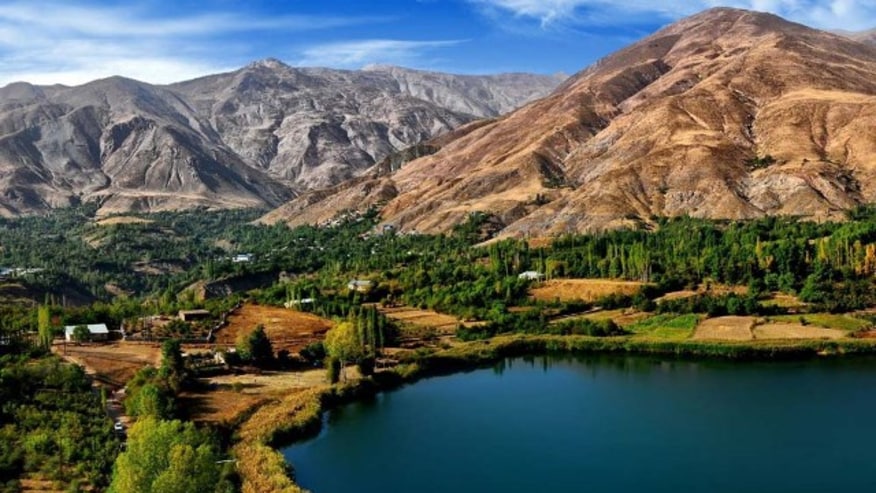
Alamut, which means “eagle’s nest”, is a mountainous geographic region in the western edge of the Alborz range, between the dry and barren plain of Qazvin in the south and the densely forested slopes of the Mazandaran province in the north.
Perched on top of a hill in a relatively remote village, a well-fortified castle is maybe the highlight of your travel to Alamut. The now-ruined castle was once sheltering the followers of Hasan-e Sabbah (1070–1124), spiritual leader of Islam’s heretical Ismaili sect, known as ‘Assassins’.
In popular myth, Sabbah led a bizarre, much-feared mercenary organization whose members were dispatched to murder or kidnap leading political and religious figures of the day. In the early 1930s, British-Italian explorer and travel writer Freya Stark described her exploration of the place in her book “The Valleys of the Assassins”.
12. Naqsh-e Rustam necropolis, near Shiraz
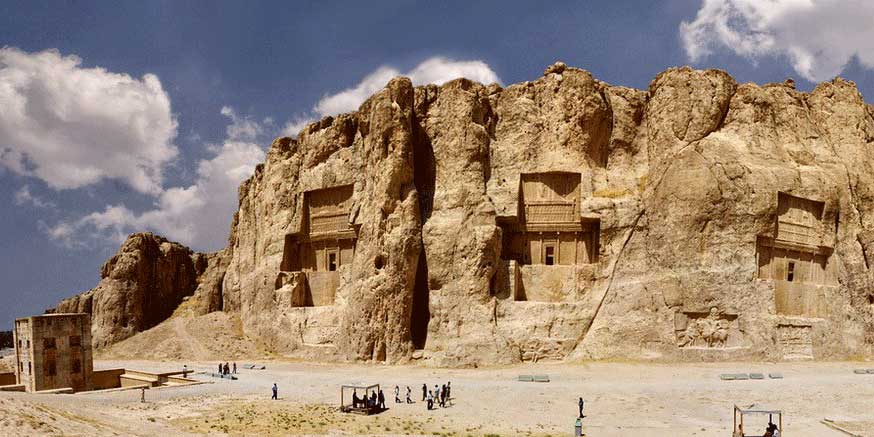
Located near Persepolis, Naqsh-e Rustam embraces massive rock-hewn tombs and royal bas-relief carvings, turning the ancient site to a must-see for holidaymakers traversing Iran. The Achaemenid necropolis is situated near Persepolis, itself a bustling UNESCO World Heritage site near the southern city of Shiraz.
Naqsh-e Rustam, meaning “Picture of Rustam” is named after mythical Iranian hero which is most celebrated in Shahnameh and Persian mythology. Back in time, natives of the region had erroneously supposed that the carvings below the tombs represent depictions of the mythical hero.
One of the wonders of the ancient world, Naqsh-e Rustam embraces four tombs are where Persian Achaemenid kings are laid to rest, believed to be those of Darius II, Artaxerxes I, Darius I and Xerxes I (from left to right facing the cliff), although some historians are still debating this. Beneath the funerary chambers are dotted with seven Sassanian-era (224–651) bas-reliefs cut into the cliff surface, depicting vivid scenes of imperial conquests and royal ceremonies; signboards below each relief give a detailed description in English.
13. Sheikh Lotfollah Mosque, Isfahan

The 17th-century Sheikh Lotfollah Mosque punctuates the middle of the two-story arcades, which are encircling the enormous Imam Square, itself a UNESCO World Heritage site in Isfahan.
Built during the reign of Shah Abbas I, the mosque was dedicated to the ruler’s father-in-law, Sheikh Lotfollah, a revered Lebanese scholar of Islam who was invited to Isfahan to oversee the king’s mosque (now the Imam Mosque).
In comparison to many mosques scattered across the country, the Sheikh Lotfollah appears to be relatively unusual, having neither a minaret nor a courtyard probably because the mosque was never intended for public use, but rather served as a worship place for women.
The mosque is very famous for having a very picturesque dome that makes extensive use of delicate yet very intricate cream-colored tiles, changing color throughout the day from cream to pink. Some say the sunset is usually the best time to witness the change. Inside the sanctuary, there are thousands of mosaics that adorn the walls and its extraordinarily gorgeous ceiling that features a series of shrinking, yellow motifs, itself a masterpiece of design. Photography is allowed but using a flash is not.
14. Tomb of Daniel, Susa
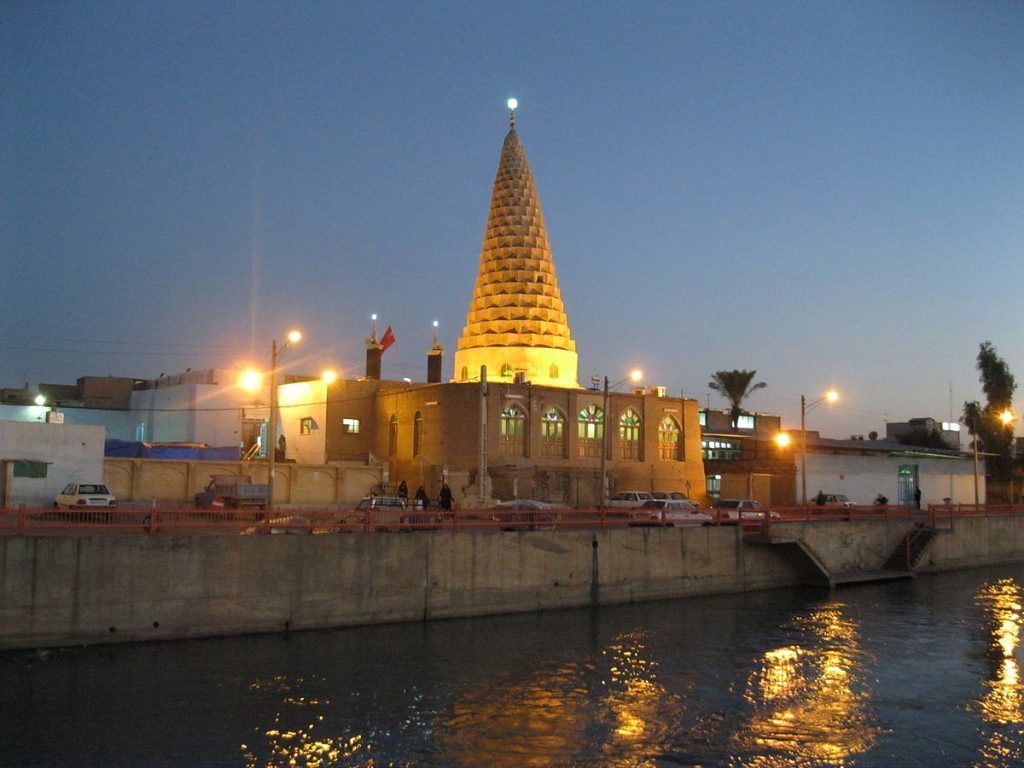
The traditional burial place of the Biblical prophet Daniel, which is located in the town Shush (Susa), is known for its distinctive conical dome.
The tomb of Daniel is not imposing from the outside, but is awesome once entering. There are mirrors reflecting light everywhere. The mausoleum cannot be missed while traversing southwest Iran, though its architecture is of no great antiquity. It contains two courtyards, each encircled by adjoining chambers and porches. The pilgrimage also offers some accommodations to visitors willing for an overnight stay.
Over the course of history, according to sources, several cities lay claim to the biblical Daniel’s last resting place, within Iran both Jews and Muslims agree that this lavish dome (pine-cone-shaped tower) marks the spot.
Shush, once a crossroads of various civilizations, is sprawled on parts of ancient Susa at the edge of the Iranian plateau in the lower Zagros mountain range.
15. Bazaar, Tabriz
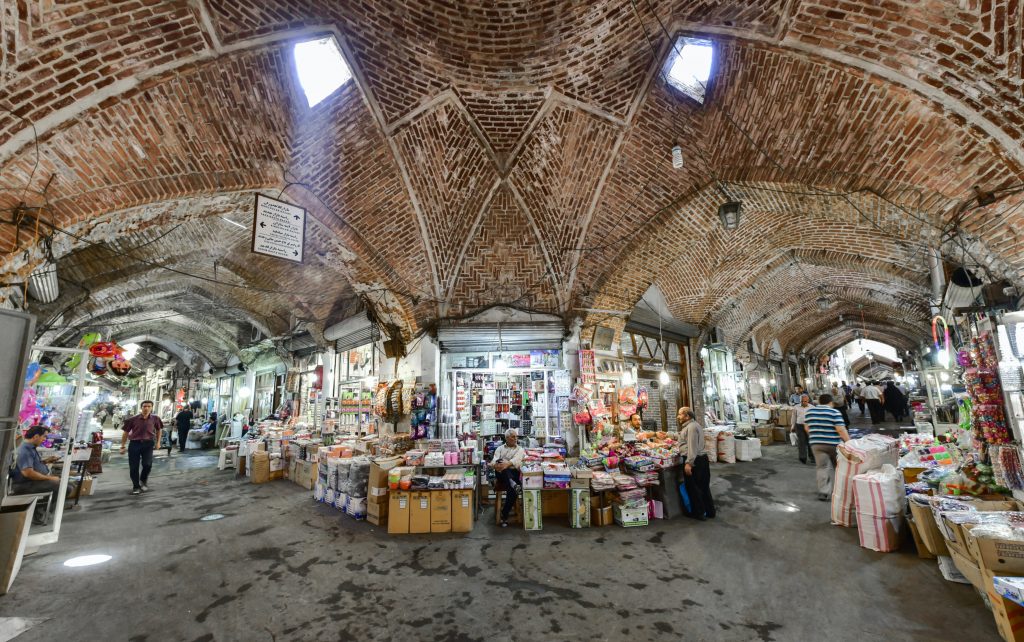
The centuries-old bazaar of Tabriz, a labyrinth of interconnected covered passages that adds up to about 5 km, embraces countless shops, over 20 caravanserais, and inns, some 20 vast domed halls, bathhouses, and mosques, as well as other brick structures and enclosed spaces for different functions.
The bazaar has been a melting pot of cultural exchange since antiquity and once a hot spot on the ancient Silk Road. Its history dates back to over a millennium ago, however the majority of fine brick vaults that capture most visitor’s eyes date from the 15th century. Most mazes and passages offer certain commodities such as carpets, metalwork, toys, clothing, jewelry, and kitchen appliances, traditional spices, herbal remedies, and natural perfumes.
One can also bump into colorful grocery stores, bookbinders, blacksmiths, tinsmiths, coppersmiths, tobacconists, tailors, flag sellers, broadcloth sellers, carpenters, shoemakers, and knife-makers. There are several divided carpet sections across the bazaar that enable visitors to watch or buy hand-woven Persian carpets and rugs with different knot density and other features.
16. Sheikh Safi al-Din Khanegah and Shrine Ensemble, Ardebil

It’s well worth to explore a microcosm of Sufism where arrays of harmonious sun-scorched domes, well-preserved and richly-ornamented facades and interiors and, above all, an atmosphere of peace and tranquility have all made a must-see stopover while traversing northwest Iran.
The ensemble is named after Sheikh Safi al-Din Ardebili (1253-1334), who was a Sufi philosopher and leader of Islamic mystic practices. Developed between the early 16th century and the end of the 18th century, this place of spiritual retreat enjoys principal elements of traditional Iranian architecture to make the best use of existing space for accommodating a variety of functions.
It embodies the essence of Sufi traditions by having a microcosmic ‘city’, which embraces a mosque, a madrasa, a library, a cistern, a bathhouse, kitchens, a hospital, as well as religious houses amongst others. The place also boasts a remarkable collection of antique artifacts.
17. Sultan Amir Ahmad Bathhouse, Kashan
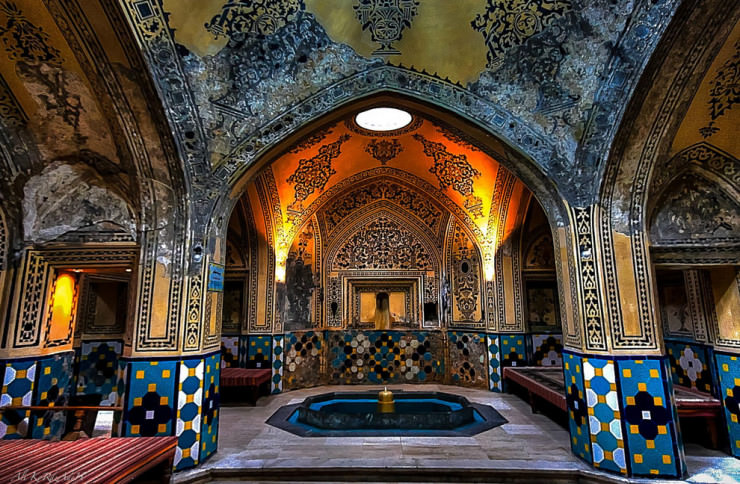
This centuries-old hammam, located in the ancient city of Kashan, is a superb example of a traditional Iranian bathhouse. Richly colored tiles and delicate painting feature throughout, and a further highlight is the panorama of the town’s minarets and badgirs viewed from the roof. Outstandingly, then, the glazed glass in the domes allowed light to filter in while keeping peeping toms out.
Its bricks are said to have stuck together using a plaster made of milk, egg white, soy flour, and lime traditionally thought to be stronger than cement.
Twisting corridors is a feature of indigenous architecture, designed to maximize the privacy of the household with the aim of keeping in the steam.
Hammams were never just about ablutions, though; they primarily functioned as a meeting place where politics would be discussed and marriages made and where men and women, assigned access at different times, could relax in their own company.
18. Vank Cathedral, Isfahan

Built in the first half of the 17th century, with the encouragement of the Safavid rulers, Kelisa-ye (the Cathedral of) Vank is a historic focal point of the Armenian Church in Iran. The cathedral is widely referred to as an endless masterpiece of architecture as it harmoniously blends Islamic motifs and elements with those of Armenian traditions. Vank means “monastery” or “convent” in the Armenian language.
The construction is said to begin in 1606 by the first arrivals being completed with major alterations to design between 1655 and 1664 under the supervision of Archbishop David. Hundreds of Armenians, who migrated to Isfahan during the Ottoman–Safavid War (1603–18), contributed to the cathedral being completed.
The Armenian quarter of Isfahan dates from the time of Shah Abbas I, who transported a colony of Christians from the town of Jolfa (now on Iran’s northern border) en masse, and named the village ‘New Jolfa’. Shah Abbas sought their skills as merchants, entrepreneurs, and artists and he ensured that their religious freedom was respected – albeit at a distance from the city’s Islamic center.
19. Takht-e Soleyman, Takab

Takht-e Soleyman (which literally translates into “Solomon’s Throne”), is an ancient isolated sanctuary on the outskirts of Takab, northwest Iran.
Situated in the southeastern highlands of West Azarbaijan province overlooking a lake with a backdrop of a snowcapped mountain range, the sanctuary bears testimony to various eras of the nation’s history.
The surrounding landscape of the sanctuary was probably first inhabited sometime in the 1st millennium BC. Some construction on the mound itself dates from the early Achaemenian dynasty (559–330 BC), and there are traces of settlement activity from the Parthian period.
The historical ensemble was established in a geologically anomalous location as the base of the temple complex sits on an oval mound roughly 350 by 550 meters. Inspired by natural context, the rich harmonious composition draws local and foreign travelers who want even for minutes revel in its peaceful atmosphere.
20. Pasargadae, Shiraz
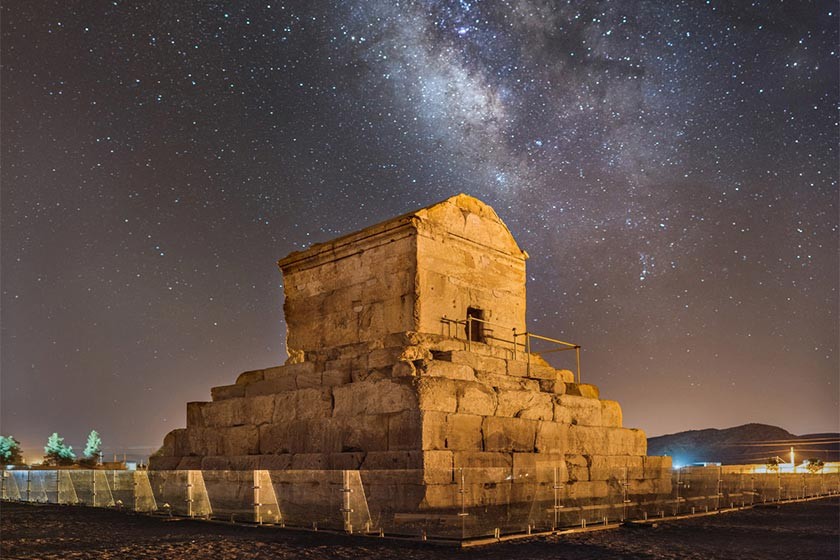
The magnificent Pasargadae, which is situated in about 50 km north of Persepolis, bears exceptional examples of the first phase of royal Achaemenid art and architecture and brilliant testimonies of Persian civilization.
Cyrus was the founder of Achaemenid Empire which at its greatest extent stretched from the Balkans to the Indus Valley, spanning 5.5 million square kilometers. The Persian king declared world’s first charter of human rights, also known as the Cyrus Cylinder.
The name may have been derived from that of the chief Persian tribe, the Pasargadae, though, according to some experts, it is possible that the original form of the name was Parsagadeh (“Throne of Pars”).






